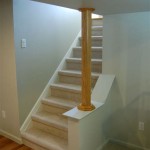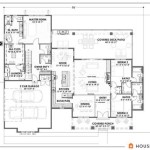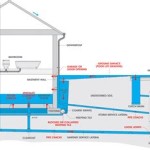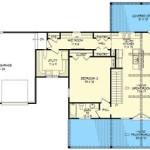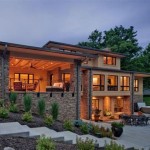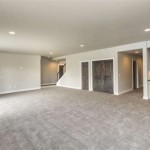House Plans With Walkout Basement and Side Garage Floors in Oregon
Oregon, with its diverse topography ranging from coastal regions to mountainous terrains, presents unique challenges and opportunities for home construction. House plans featuring a walkout basement and a side garage are particularly well-suited to the state's landscape, offering practical solutions for maximizing space and integrating the home with its surroundings. These designs cater to both aesthetic preferences and functional needs, effectively utilizing sloping lots common in many Oregon communities.
The allure of a walkout basement lies in its ability to transform what is typically considered underground space into a fully functional and naturally lit extension of the home. This type of basement takes advantage of a sloping lot, allowing for a ground-level entrance on one side. Simultaneously, a side garage, often integrated seamlessly into the house's design, offers convenient access and preserves the street-facing aesthetics of the property. In Oregon, where outdoor living is highly valued, these design elements are particularly appealing.
Advantages of Walkout Basements in Oregon
One of the primary benefits of a walkout basement is its versatility. Unlike traditional basements, which can feel dark and confined, a walkout basement offers ample natural light and direct access to the outdoors. This makes it an ideal space for a variety of uses, including additional living areas, home offices, recreation rooms, or even rental units, provided local zoning regulations allow. In Oregon, this extra living space can be particularly valuable given the fluctuating weather patterns, offering a comfortable and adaptable environment regardless of the season.
The increased natural light and ventilation inherent in a walkout basement also contribute to improved air quality and reduced moisture levels. This is particularly important in Oregon, where rainfall is abundant, and damp conditions can lead to mold and mildew growth in traditional basements. The direct access to the outdoors allows for easy ventilation, helping to maintain a healthy and comfortable living environment.
Furthermore, a walkout basement adds significant value to a home. The additional finished square footage, coupled with the access and natural light, makes the property more attractive to potential buyers. This is particularly true in Oregon's competitive real estate market, where buyers often prioritize homes that offer flexible living spaces and seamless integration with the outdoors. A well-designed walkout basement can significantly enhance the resale value of a home in Oregon.
From a construction standpoint, building a walkout basement requires careful consideration of the site’s topography and soil conditions. Proper drainage is crucial to prevent water from entering the basement. This often involves implementing strategies such as grading the land away from the foundation, installing French drains, and using waterproof membranes. In Oregon, where soil types vary significantly, a thorough geotechnical analysis is essential to ensure the stability and longevity of the structure.
Integration of the Side Garage
A side garage, strategically positioned on the side of the house, offers numerous advantages in terms of aesthetics and functionality. Unlike front-facing garages, which can dominate the facade of a home, a side garage minimizes its visual impact, allowing for a more attractive and inviting street presence. This is particularly important in Oregon communities that value architectural harmony and curb appeal.
The location of the side garage also allows for better utilization of the front yard. Without the need for a long driveway leading to a front-facing garage, more space can be devoted to landscaping, gardens, or outdoor living areas. This enhances the overall aesthetic appeal of the property and creates a more welcoming environment. In Oregon, where homeowners often prioritize outdoor enjoyment, this is a significant advantage.
From a practical standpoint, a side garage can offer more convenient access to the home, particularly when combined with a mudroom or entryway strategically located near the garage entrance. This allows for a seamless transition between the garage and the main living areas, making it easier to unload groceries, store outdoor gear, and manage daily routines. In Oregon, where outdoor activities are prevalent, this convenience is highly valued.
Integrating the side garage into the overall house design requires careful planning and attention to detail. The architectural style of the garage should complement the design of the main house, creating a cohesive and visually appealing whole. The choice of materials, colors, and rooflines should be consistent with the overall aesthetic of the property. In Oregon, where architectural styles range from traditional to modern, it is important to select a design that reflects the local character and preferences.
Access to the side garage typically involves a driveway that runs along the side of the house. The design and construction of this driveway should take into account the site’s topography, soil conditions, and drainage requirements. Proper grading and paving are essential to ensure that the driveway is safe and functional, particularly during the rainy season. In Oregon, where winter conditions can be challenging, it is important to select durable and weather-resistant materials for the driveway.
Key Considerations for House Plans in Oregon
When designing house plans with a walkout basement and a side garage in Oregon, several key considerations must be taken into account. These include local building codes, zoning regulations, environmental factors, and energy efficiency standards. Navigating these requirements can be complex, and it is often advisable to work with an experienced architect or builder who is familiar with the local conditions and regulations.
Oregon’s building codes are designed to ensure the safety and structural integrity of buildings. These codes cover a wide range of topics, including foundation design, framing, electrical wiring, plumbing, and mechanical systems. When building a walkout basement, it is particularly important to adhere to the code requirements for waterproofing, drainage, and ventilation. Similarly, when constructing a side garage, it is essential to comply with the code requirements for fire separation, access, and parking.
Zoning regulations dictate how land can be used and what types of buildings can be constructed on a particular property. These regulations may specify setbacks, height restrictions, and lot coverage limits. Before embarking on a building project, it is important to review the local zoning regulations to ensure that the proposed house plan complies with all applicable requirements. Violations of zoning regulations can result in costly delays and fines.
Oregon’s unique environmental conditions also require careful consideration. In areas prone to earthquakes, it is important to incorporate seismic-resistant design features into the house plan. In areas subject to flooding, it is essential to elevate the building above the base flood elevation. When building near environmentally sensitive areas, it may be necessary to obtain special permits and implement mitigation measures to protect natural resources.
Energy efficiency is another important consideration for house plans in Oregon. The state has adopted stringent energy efficiency standards that are designed to reduce energy consumption and greenhouse gas emissions. These standards cover a wide range of building components, including insulation, windows, doors, and HVAC systems. Building an energy-efficient home can not only reduce utility bills but also improve indoor comfort and air quality.
The selection of materials is also crucial for durability and aesthetic appeal. Oregon’s climate, with its wet winters and mild summers, requires materials that are resistant to moisture, rot, and decay. Locally sourced materials, such as cedar and Douglas fir, are often a popular choice for siding, trim, and decking. These materials are not only beautiful but also durable and sustainable.
Landscaping should also be carefully considered. The design of the landscaping should complement the architecture of the house and enhance the overall aesthetic appeal of the property. Native plants are often a good choice, as they are well-adapted to the local climate and require less maintenance. Landscaping can also play a role in water conservation by reducing the need for irrigation.
Furthermore, the integration of smart home technology can enhance the functionality and convenience of the home. Smart thermostats, lighting controls, and security systems can improve energy efficiency, enhance security, and simplify daily routines. In Oregon, where technology adoption is high, smart home features are often a sought-after amenity.
Ultimately, designing house plans with a walkout basement and a side garage in Oregon requires a holistic approach that considers both the functional needs of the homeowner and the unique characteristics of the site. By working with experienced professionals and paying attention to detail, it is possible to create a home that is both beautiful and sustainable.

Design Trend Hillside House Plans With Walk Out Basement Floor The Plan Company

Country Style House Plan 3 Beds 2 5 Baths 2398 Sq Ft 932 1096 Eplans Com

Wallowa House Plan Two Story Mountain Prairie Home Design

Alpine Basement Floor Plan Signature Collection Lexar Homes

Craftsman Style House Plan 4 Beds Baths 2896 Sq Ft 929 970 Eplans Com

Contemporary Style House Plan 3 Beds 2 Baths 2457 Sq Ft 932 1053 Eplans Com

Craftsman Style House Plan 4 Beds 3 Baths 2906 Sq Ft 124 1242 Eplans Com

Craftsman Style House Plan 4 Beds 3 5 Baths 3132 Sq Ft 929 407 Eplans Com

Farmhouse Style House Plan 2 Beds Baths 2970 Sq Ft 932 1049 Floorplans Com

Drive Under House Plans
